-

新人教版高中英语选修2Unit 4 Journey Across a Vast Land教学设计
当孩子们由父母陪同时,他们才被允许进入这个运动场。3.过去分词(短语)作状语时的几种特殊情况(1)过去分词(短语)在句中作时间、条件、原因、让步状语时,相当于对应的时间、条件、原因及让步状语从句。Seen from the top of the mountain (=When it is seen from the top of the mountain), the whole town looks more beautiful.从山顶上看,整个城市看起来更美了。Given ten more minutes (=If we are given ten more minutes), we will finish the work perfectly.如果多给十分钟,我们会完美地完成这项工作。Greatly touched by his words (=Because she was greatly touched by his words), she was full of tears.由于被他的话深深地感动,她满眼泪花。Warned of the storm (=Though they were warned of the storm), the farmers were still working on the farm.尽管被警告了风暴的到来,但农民们仍在农场干活。(2)过去分词(短语)在句中作伴随、方式等状语时,可改为句子的并列谓语或改为并列分句。The teacher came into the room, followed by two students (=and was followed by two students).后面跟着两个学生,老师走进了房间。He spent the whole afternoon, accompanied by his mom(=and was accompanied by his mom).他由母亲陪着度过了一整个下午。

新人教版高中英语选修2Unit 1 Science and Scientists-Using langauge教学设计
This happens because the dish soap molecules have a strong negative charge, and the milk molecules have a strong positive charge. Like magnets, these molecules are attracted to each other, and so they appear to move around on the plate, taking the food coloring with them, making it look like the colors are quickly moving to escape from the soap.Listening text:? Judy: Oh, I'm so sorry that you were ill and couldn't come with us on our field trip. How are you feeling now? Better?? Bill: Much better, thanks. But how was it?? Judy: Wonderful! I especially liked an area of the museum called Light Games.it was really cool. They had a hall of mirrors where I could see myself reflected thousands of times!? Bill: A hall of mirrors can be a lot of fun. What else did they have?? Judy: Well, they had an experiment where we looked at a blue screen for a while, and then suddenly we could see tiny bright lights moving around on it. You'll never guess what those bright lights were!? Bill: Come on, tell me!? Judy: They were our own blood cells. For some reason, our eyes play tricks on us when we look at a blue screen, and we can see our own blood cells moving around like little lights! But there was another thing I liked better. I stood in front of a white light, and it cast different shadows of me in every color of the rainbow!? Bill: Oh, I wish I had been there. Tell me more!? Judy: Well, they had another area for sound. They had a giant piano keyboard that you could use your feet to play. But then, instead of playing the sounds of a piano, it played the voices of classical singers! Then they had a giant dish, and when you spoke into it, it reflected the sound back and made it louder. You could use it to speak in a whisper to someone 17 meters away.? Bill: It all sounds so cool. I wish I could have gone with you? Judy: I know, but we can go together this weekend. I'd love to go there again!? Bill: That sounds like a great idea!

新人教版高中英语选修2Unit 3 Food and Culture-Discovering useful structures教学设计
The newspaper reported more than 100 people had been killed in the thunderstorm.报纸报道说有一百多人在暴风雨中丧生。(2)before、when、by the time、until、after、once等引导的时间状语从句的谓语是一般过去时,以及by、before后面接过去的时间时,主句动作发生在从句的动作或过去的时间之前且表示被动时,要用过去完成时的被动语态。By the time my brother was 10, he had been sent to Italy.我弟弟10岁前就已经被送到意大利了。Tons of rice had been produced by the end of last month. 到上月底已生产了好几吨大米。(3) It was the first/second/last ... time that ...句中that引导的定语从句中,主语与谓语构成被动关系时,要用过去完成时的被动语态。It was the first time that I had seen the night fact to face in one and a half years. 这是我一年半以来第一次亲眼目睹夜晚的景色。(4)在虚拟语气中,条件句表示与过去事实相反,且主语与谓语构成被动关系时,要用过去完成时的被动语态。If I had been instructed by him earlier, I would have finished the task.如果我早一点得到他的指示,我早就完成这项任务了。If I had hurried, I wouldn't have missed the train.如果我快点的话,我就不会误了火车。If you had been at the party, you would have met him. 如果你去了晚会,你就会见到他的。

新人教版高中英语选修2Unit 3 Food and Culture-Reading and thinking教学设计
The discourse explores the link between food and culture from a foreign’s perspective and it records some authentic Chinese food and illustrates the cultural meaning, gerography features and historic tradition that the food reflects. It is aimed to lead students to understand and think about the connection between food and culture. While teaching, the teacher should instruct students to find out the writing order and the writer’s experieces and feelings towards Chinese food and culture.1.Guide the students to read the text, sort out the information and dig out the topic.2.Understand the cultural connotation, regional characteristics and historical tradition of Chinese cuisine3.Understand and explore the relationship between food and people's personality4.Guide the students to use the cohesive words in the text5.Lead students to accurately grasp the real meaning of the information and improve the overall understanding ability by understanding the implied meaning behind the text.1. Enable the Ss to understand the structure and the writing style of the passage well.2. Lead the Ss to understand and think further about the connection between food and geography and local character traits.Step1: Prediction before reading. Before you read, look at the title, and the picture. What do you think this article is about?keys:It is about various culture and cuisine about a place or some countries.

新人教版高中英语选修2Unit 5 First Aid-Discovering useful structures教学设计
You have no excuse for not going.你没有理由不去。He was punished for not having finished his homework.他因未完成作业而受到惩罚。2.动词ing形式复合结构由物主代词或人称代词宾格、名词所有格或普通格加动词ing,即“sb./sb.'s+doing”构成。动词ing形式的复合结构实际上是给动词ing形式加了一个逻辑主语。动词ing形式的复合结构有四种形式:①形容词性物主代词+动词ing②名词所有格+动词ing③代词宾格+动词ing④名词+动词ingHer coming to help encouraged all of us.她来帮忙鼓舞了我们所有人。The baby was made awake by the door suddenly shutting.这个婴儿被突然的关门声吵醒了。Can you imagine him/Jack cooking at home?你能想象他/杰克在家做饭的样子吗?无生命名词无论是作主语还是作宾语都不能用第②种形式。Tom's winning first prize last year impressed me a lot.汤姆去年得了一等奖使我印象深刻。Do you mind my/me/Jack's/Jack leaving now?你介意我/杰克现在离开吗?Excuse me for my not coming on time.很抱歉我没能按时来。His father's being ill made him worried.他父亲病了,他很担心。We are looking forward to the singer's/the singer to give us a concert.我们盼望着这位歌手来给我们举办一场演唱会。

新人教版高中英语必修3Unit 2 Morals and Virtues-Listening &Speaking&Talking教学设计
Example:One day, a poor boy who was trying to pay his way through school by sending newspapers door to door found that he only had one dime(一角)left. He was so hungry that he decided to beg for a meal at the next house.However, he lost his nerve when a lovely young woman opened the door. Instead of a meal he asked for a drink of water. She thought he looked hungry so she brought him a large glass of milk. He drank it slowly, and then asked, “How much do I owe you?” “You don’t owe me anything,” she replied, “Mother has taught me never to accept pay for a kindness.” “Then I thank you from the bottom of my heart.” With these words, Howard Kelly left that house.Years later the woman became badly ill and was finally sent to the hospital in a big city. Dr. Howard Kelly, now famous, was called in. When he heard the name of the town she came from, a strange light filled his eyes. Dressed in his doctor’s clothes, Dr. Kelly went into her room and recognized her at once. From that day on, he gave special attention to her, and decided to do his best to save her life.At last the woman was saved. Dr. Kelly asked the business office to pass the final bill to him. He looked at it and then wrote something on the side. The bill was sent to the woman’s room. She was afraid to open it because she was sure that it would take the rest of her life to pay for it off. Finally she looked, and the note on the side of the bill caught her attention. She read these words: “Paid in full with a glass of milk, Dr. Howard Kelly.” Tear of joy flooded her eyes.

新人教版高中英语选修2Unit 1 Science and Scientists-Learning about Language教学设计
Step 7: complete the discourse according to the grammar rules.Cholera used to be one of the most 1.__________ (fear) diseases in the world. In the early 19th century, _2_________ an outbreak of cholera hit Europe, millions of people died. But neither its cause, 3__________ its cure was understood. A British doctor, John Snow, wanted to solve the problem and he knew that cholera would not be controlled _4_________ its cause was found. In general, there were two contradictory theories 5 __________ explained how cholera spread. The first suggested that bad air caused the disease. The second was that cholera was caused by an _6_________(infect) from germs in food or water. John Snow thought that the second theory was correct but he needed proof. So when another outbreak of cholera hit London in 1854, he began to investigate. Later, with all the evidence he _7_________ (gather), John Snow was able to announce that the pump water carried cholera germs. Therefore, he had the handle of the pump _8_________ (remove) so that it couldn't be used. Through his intervention,the disease was stopped in its tracks. What is more, John Snow found that some companies sold water from the River Thames that __9__________________ (pollute) by raw waste. The people who drank this water were much more likely _10_________ (get) cholera than those who drank pure or boiled water. Through John Snow's efforts, the _11_________ (threaten) of cholera around the world saw a substantial increase. Keys: 1.feared 2.when 3. nor 4.unless 5.that/which 6.infection 7.had gathered 8.removed 9.was polluted 10.to get 11. threat

新人教版高中英语选修2Unit 1 Science and Scientists-Reading and thinking教学设计
Step 5: After learning the text, discuss with your peers about the following questions:1.John Snow believed Idea 2 was right. How did he finally prove it?2. Do you think John Snow would have solved this problem without the map?3. Cholera is a 19th century disease. What disease do you think is similar to cholera today?SARS and Covid-19 because they are both deadly and fatally infectious, have an unknown cause and need serious public health care to solve them urgently.keys:1. John Snow finally proved his idea because he found an outbreak that was clearly related to cholera, collected information and was able to tie cases outside the area to the polluted water.2. No. The map helped John Snow organize his ideas. He was able to identify those households that had had many deaths and check their water-drinking habits. He identified those houses that had had no deaths and surveyed their drinking habits. The evidence clearly pointed to the polluted water being the cause.3. SARS and Covid-19 because they are both deadly and fatally infectious, have an unknown cause and need serious public health care to solve them urgently.Step 6: Consolidate what you have learned by filling in the blanks:John Snow was a well-known _1___ in London in the _2__ century. He wanted to find the _3_____ of cholera in order to help people ___4_____ it. In 1854 when a cholera __5__ London, he began to gather information. He ___6__ on a map ___7___ all the dead people had lived and he found that many people who had ___8____ (drink) the dirty water from the __9____ died. So he decided that the polluted water ___10____ cholera. He suggested that the ___11__ of all water supplies should be _12______ and new methods of dealing with ____13___ water be found. Finally, “King Cholera” was __14_____.Keys: 1. doctor 2. 19th 3.cause 4.infected with 5.hit 6.marked 7.where 8.drunk 9.pump 10.carried 11.source 12.examined 13.polluted 14.defeatedHomework: Retell the text after class and preview its language points
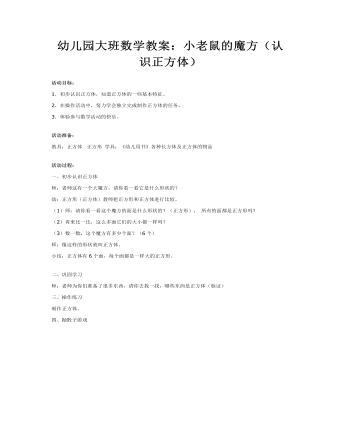
大班数学教案:小老鼠的魔方
2.在操作活动中,努力学会独立完成制作正方体的任务。 3.体验参与数学活动的快乐。 活动准备: 教具:正方体 正方形学具:《幼儿用书》各种长方体及正方体的物品 活动过程: 一、初步认识正方体 师:老师这有一个大魔方,请你看一看它是什么形状的? 幼:正方形(正方体)教师把正方形和正方体进行比较。 (1)师:请你看一看这个魔方的面是什么形状的?(正方形),所有的面都是正方形吗?
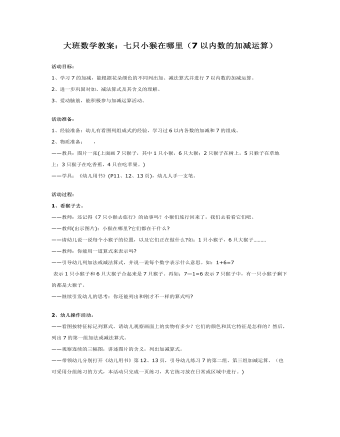
大班数学教案:七只小猴在哪里
活动准备: 1、经验准备:幼儿有看图列组成式的经验,学习过6以内各数的加减和7的组成。 2、物质准备: , ——教具:图片一张(上面画7只猴子,其中1只小猴,6只大猴;2只猴子在树上,5只猴子在草地上;3只猴子在吃香蕉,4只在吃苹果。) ——学具:《幼儿用书》(P11、12、13页),幼儿人手一支笔。活动过程: 1、看猴子去。 ——教师:还记得《7只小猴去旅行》的故事吗?小猴们旅行回来了,我们去看看它们吧。 ——教师(出示图片):小猴在哪里?它们都在干什么? ——请幼儿说一说每个小猴子的位置,以及它们正在做什么?如:1只小猴子,6只大猴子………
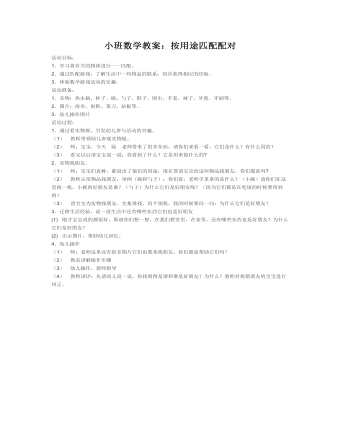
小班数学教案:按用途匹配配对
2.通过匹配游戏,了解生活中一些物品的联系,初步获得相应的经验。 3.体验数学游戏活动的乐趣。 活动准备: 1.实物:热水瓶、杯子、碗、勺子、鞋子、围巾、手套、袜子、牙膏、牙刷等。 2.图片:雨伞、雨鞋、菜刀、砧板等。 3.幼儿操作图片 活动过程: 1.通过看实物展,引发幼儿参与活动的兴趣。 (1) 教师带领幼儿参观实物展。 (2) 师:宝宝,今天 陆 老师带来了很多东西,请你们来看一看,它们是什么?有什么用的? (3) 看完以后请宝宝说一说:你看到了什么?它是用来做什么的? 2.实物找朋友。 (1) 师:宝宝们真棒,都说出了他们的用途,现在要请宝宝给这些物品找朋友,你们愿意吗?
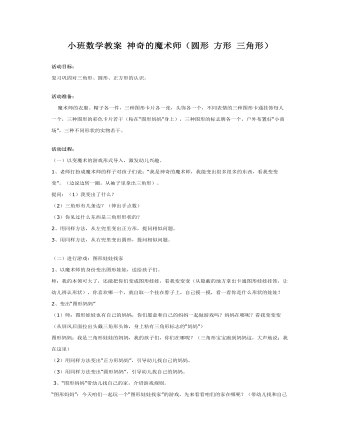
小班数学教案 神奇的魔术师
活动准备: 魔术师的衣服、帽子各一件,三种图形卡片各一张,头饰各一个,不同表情的三种图形卡通挂饰每人一个,三种图形的彩色卡片若干(粘在“图形妈妈”身上),三种图形的标志牌各一个,户外布置好“小商场”,三种不同形状的实物若干。 活动过程:(一)以变魔术的游戏形式导入,激发幼儿兴趣。 1、老师打扮成魔术师的样子对孩子们说:“我是神奇的魔术师,我能变出很多很多的东西,看我变变变”。(边说边转一圈,从袖子里拿出三角形)。 提问:(1)我变出了什么? (2)三角形有几条边?(伸出手点数) (3)你见过什么东西是三角形形状的? 2、用同样方法,从左兜里变出正方形,提问相似问题。 3、用同样方法,从右兜里变出圆形,提问相似问题。 (二)进行游戏:图形娃娃找家 1、以魔术师的身份变出图形娃娃,送给孩子们。 师:我的本领可大了,还能把你们变成图形娃娃,看我变变变(从隐蔽的地方拿出卡通图形娃娃挂饰,让幼儿辨认形状),你喜欢哪一个,就自取一个挂在脖子上,自己摸一摸,看一看你是什么形状的娃娃?
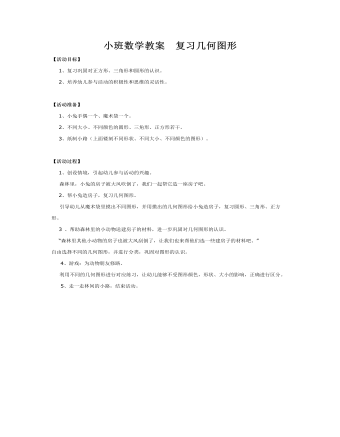
小班数学教案 复习几何图形
【活动准备】 1、小兔手偶一个、魔术袋一个。 2、不同大小、不同颜色的圆形、三角形、正方形若干。 3、纸制小路(上面镂刻不同形状、不同大小、不同颜色的图形)。 【活动过程】 1、创设情境,引起幼儿参与活动的兴趣。 森林里,小兔的房子被大风吹倒了,我们一起帮它造一座房子吧。 2、帮小兔造房子,复习几何图形。 引导幼儿从魔术袋里摸出不同图形,并用摸出的几何图形给小兔造房子,复习圆形、三角形、正方形。
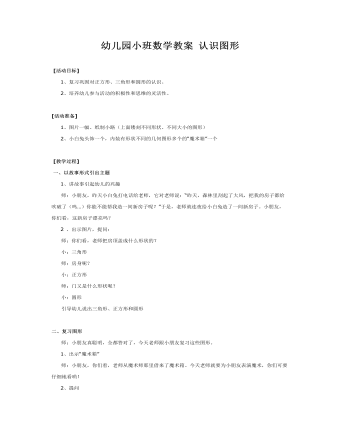
幼儿园小班数学教案 认识图形
[活动准备] 1、图片一幅、纸制小路(上面镂刻不同形状、不同大小的图形) 2、小白兔头饰一个,内装有形状不同的几何图形多个的“魔术箱”一个 [教学过程] 一、以故事形式引出主题 1、讲故事引起幼儿的兴趣 师:小朋友,昨天小白兔打电话给老师,它对老师说:“昨天,森林里刮起了大风,把我的房子都给吹破了(呜…)你能不能帮我造一间新房子呢?”于是,老师就连夜给小白兔造了一间新房子。小朋友,你们看,这新房子漂亮吗? 2 、出示图片,提问: 师:你们看,老师把房顶盖成什么形状的? 小:三角形 师:房身呢? 小:正方形 师:门又是什么形状呢? 小:圆形 引导幼儿说出三角形、正方形和圆形

幼儿园小班数学教案 鞋子配对
2、初步培养观察力和动手能力,萌发对科学活动的兴趣。 3、养成自己整理鞋子的良好习惯。 重点:按鞋子的大小、颜色、款式等特点进行配对。 难点:寻找鞋底的秘密,特别是形状:两头大中间向里凹,但两只鞋子的朝向是相反的。 二、活动准备: 1、与幼儿人数相近的大小、颜色、款式各异的鞋子散落放在鞋架上,用布先遮起来,人手一张白纸。 2 、欢快的音乐一段。 3、半圆形的座位安排,中间留有空地,便于活动。 三、活动过程 (一)奇怪的鞋子 1、教师以故事的形式引出:娃娃家里的宝宝呀,特别爱漂亮,她每天都要换一双新鞋子,所以她的鞋子特别多,最后,连她自己都分不清哪两只是一双了,有一天他穿了一双很特别的鞋子,一只是大的红鞋子,一只是小一点儿的花鞋子(教师边讲边出示两只鞋子),可是这一天,她非常不开心,你们知道她为什么不开心吗?(幼儿猜测,引导幼儿发现两只鞋子的不同) 2、教师小结:两只大小不同、形状不同、颜色也不一样的鞋子不是一双,所以穿的人当然就不舒服了。
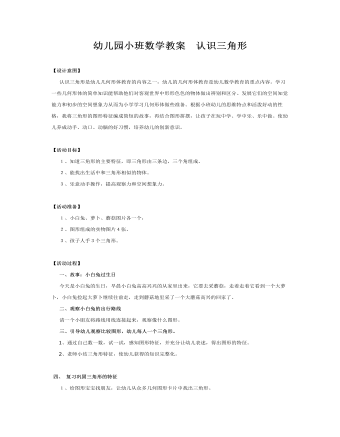
幼儿园小班数学教案 认识三角形
【活动目标】 1、知道三角形的主要特征,即三角形由三条边,三个角组成。 2、能找出生活中和三角形相似的物体。 3、乐意动手操作,提高观察力和空间想象力。 【活动准备】 1、小白兔、萝卜、蘑菇图片各一个, 2、图形组成的实物图片4张。 3、孩子人手3个三角形。 【活动过程】 一、故事:小白兔过生日 今天是小白兔的生日,早晨小白兔高高兴兴的从家里出来,它要去采蘑菇,走着走着它看到一个大萝卜,小白兔捡起大萝卜继续往前走,走到蘑菇地里采了一个大蘑菇高兴的回家了。
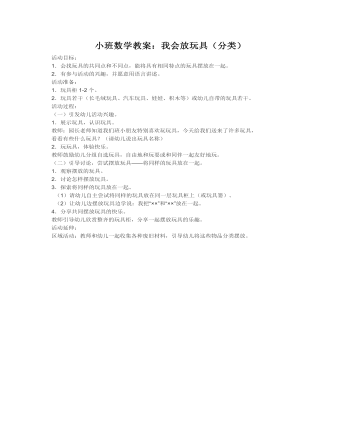
小班数学教案:我会放玩具(分类)
2.有参与活动的兴趣,并愿意用语言讲述。 活动准备: 1.玩具柜1-2个。 2.玩具若干(长毛绒玩具、汽车玩具、娃娃、积木等)或幼儿自带的玩具若干。 活动过程: (一)引发幼儿活动兴趣。 1.展示玩具,认识玩具。 教师:园长老师知道我们班小朋友特别喜欢玩玩具,今天给我们送来了许多玩具, 看看有些什么玩具?(请幼儿说出玩具名称) 2.玩玩具,体验快乐。 教师鼓励幼儿分组自选玩具,自由地和玩耍或和同伴一起友好地玩。
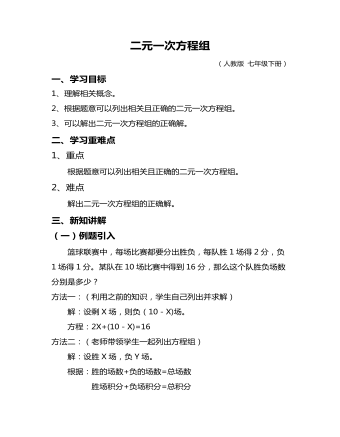
初中数学人教版二元一次方程组教学设计教案
(一)例题引入篮球联赛中,每场比赛都要分出胜负,每队胜1场得2分,负1场得1分。某队在10场比赛中得到16分,那么这个队胜负场数分别是多少?方法一:(利用之前的知识,学生自己列出并求解)解:设剩X场,则负(10-X)场。方程:2X+(10-X)=16方法二:(老师带领学生一起列出方程组)解:设胜X场,负Y场。根据:胜的场数+负的场数=总场数 胜场积分+负场积分=总积分得到:X+Y=10 2X+Y=16
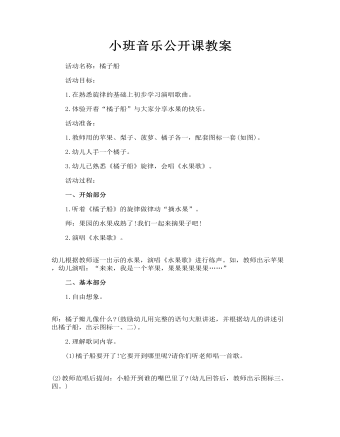
小班音乐公开课教案
一、开始部分 1.听着《橘子船》的旋律做律动“摘水果”。 师:果园的水果成熟了!我们一起来摘果子吧! 2.演唱《水果歌》。 幼儿根据教师逐一出示的水果,演唱《水果歌》进行练声。如,教师出示苹果,幼儿演唱:“来来,我是一个苹果,果果果果果果……”

小班数学教案:花儿朵朵(3以内数量)
2、在观察图片和提问的引导下,探索用点卡表示实物的数量。 3、喜爱参加数学活动,体验活动的乐趣。 活动准备: 1、教具——花的图片6张,其中数量为1、2、3的花朵两张; ——1、2、3、的点卡片各一张,分类和底板。 2、学具——操作材料人手一套实物和点卡操作图片,分类盒人手一个。 活动过程: 一、 感知图片数量,认识点子标记。 1、师:小朋友看这儿有什么?每张图片上有几朵花?我们一起来数一数好吗?

